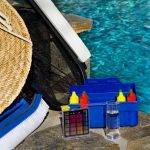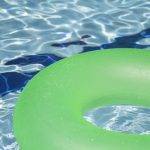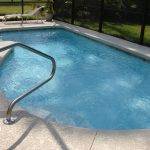Maintaining the proper balance of free chlorine and cyanuric acid in your pool is like trying to get a tan outside. Too much cyanuric acid is like slathering on SPF 150 sunscreen, which prevents you from getting any sun at all. But too little cyanuric acid is like using only SPF 20, which can lead to painful burns. Just like with SPF, your pool needs the right balance of FC to CYA. In this article, we’ll show you how to use our FC/CYA calculator to determine your pool’s ideal chlorine levels and keep your water safe and clear all season long.
TFP's Recommended Free Chlorine Levels
Use the selector below to choose your goal and current CYA level.
Liquid Chlorine | ||
|---|---|---|
| CYA Level | Minimum | Target Range |
| 20 | 2 | 3-5 |
| 30 | 2 | 4-6 |
| 40 | 3 | 5-7 |
| 50 | 4 | 6-8 |
| 60 | 5 | 7-9 |
| 70 | 5 | 8-10 |
| 80 | 6 | 9-11 |
| 90 | 7 | 10-12 |
| 100 | 8 | 11-13 |
Salt Water Chlorine | ||
|---|---|---|
| CYA Level | Minimum | Target Range |
| 20 | 2 | 3-5 |
| 30 | 2 | 3-6 |
| 40 | 2 | 3-7 |
| 50 | 2 | 3-8 |
| 60 | 3 | 4-9 |
| 70 | 3 | 5-10 |
| 80 | 4 | 6-11 |
| 90 | 4 | 6-12 |
| 100 | 5 | 7-13 |
SLAM | ||
|---|---|---|
| CYA Level | Slam Level | |
| 20 | 10 | |
| 30 | 12 | |
| 40 | 16 | |
| 50 | 20 | |
| 60 | 24 | |
| 70 | 28 | |
| 80 | 31 | |
| 90 | 35 | |
| 100 | 39 | |
The Importance of Cyanuric Acid and Free Chlorine Levels in Pool Maintenance
One cornerstone of TFPC is understanding the relationship between stabilizer and free chlorine. Stabilizer or cyanuric acid (CYA) protects your free chlorine (FC) from the sun. With no CYA stabilizer in your pool, FC will be quickly consumed by sun exposure instead of doing its job to oxidize organic material like bacteria and algae. If your FC level drops too low in your pool, you risk allowing algae to grow. The more stabilizer present in your water, the more free chlorine you need to sanitize your pool effectively. Maintaining proper levels of FC according to CYA keeps your water safe and clear without using ineffective, expensive chemicals like algaecides.
Users need to be mindful that their pool’s free chlorine levels will decrease after addition to the water. In the summer, an average pool may lose 3 ppm of FC per day, while it can take weeks to lose 3 ppm of CYA. To ensure users maintain a proper FC level, we recommend testing often with a high-quality test kit as discussed in Swimming Pool Test Kits Compared. Additionally, TFP recommends using primarily liquid chlorine or a salt water generator. This will prevent your cyanuric acid level from getting too high.
Why should you trust Trouble Free Pool?
We are pool owners who have had the same struggles caring for our pools! Over the years our members have confirmed through real world experience that the TFPC method works. The results speak for themselves.
Pool stores and the pool care industry recommend free chlorine levels from 1–3 ppm that are often inadequate for sanitation and algae prevention. Their recommendations are based on outdated information that only focused on individual chemical levels as opposed to the ways that the different chemicals in your pool affect each other. TFP teaches that your pool’s ideal free chlorine level depends heavily on your cyanuric acid level.





